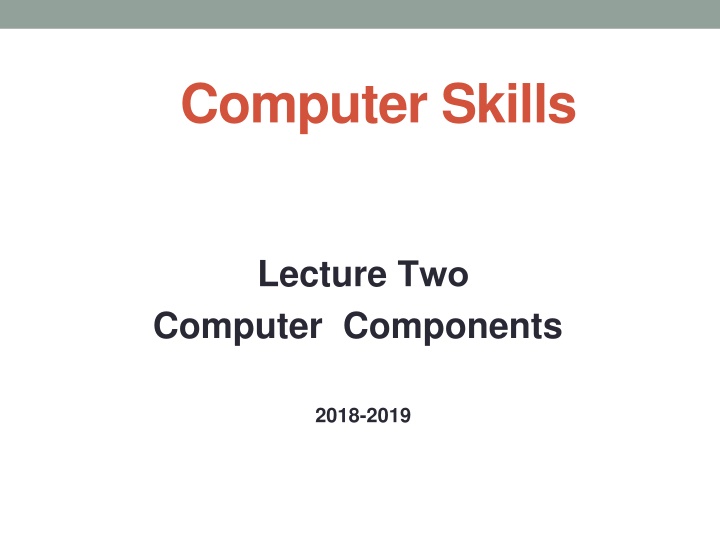
Computer Components and Operations in Information Processing Cycle
Explore the world of computer components and operations in the information processing cycle. Learn about hardware, software, input, processing, output, storage, data representation, and the essential components that make up a computer system.
Uploaded on | 0 Views
Download Presentation

Please find below an Image/Link to download the presentation.
The content on the website is provided AS IS for your information and personal use only. It may not be sold, licensed, or shared on other websites without obtaining consent from the author. If you encounter any issues during the download, it is possible that the publisher has removed the file from their server.
You are allowed to download the files provided on this website for personal or commercial use, subject to the condition that they are used lawfully. All files are the property of their respective owners.
The content on the website is provided AS IS for your information and personal use only. It may not be sold, licensed, or shared on other websites without obtaining consent from the author.
E N D
Presentation Transcript
Computer Skills Lecture Two Computer Components 2018-2019
index Computer definition Computer operations Hardware Computer System Components information processing cycle Data representation Devices(Hardware)
Computer definition An electronic device that stores, retrieves, and processes data, and can instructions. A computer is composed of hardware and software, and can exist in a variety of sizes and configurations. be programmed with Hardware: The physical parts of a computer Software: The instructions that makes the computer work
Computer Operations It performs three main operations: Receive input (data: raw facts). Process it according to predefined instructions. Produce output (information: meaningful data).
5 Hardware The term hardware refers to the physical components of your computer such as the system unit, mouse, keyboard, monitor etc. Hardware: The physical parts of a computer Internal hardware Located inside the main box (system unit) of the computer External hardware Located outside the system unit and plug into ports located on the exterior of the system unit Hardware associated with computer operations
6 Computer System Components Every computer system is made up of multiple electronic components. These components fall into four broad categories that serve different purposes in the information processing cycle
7 Computer System Components (cont.) Input: Components that help humans put data into the computer. Processing: Components that move and process the data inside the computer. Output: Components that provide the results of the processing to humans. Storage: Components that store software and data until it is needed.
Information processing cycle The four-step process that data moves through as it is processed by a computer. Consists of input, processing, output, and storage.
9 Data representation The smallest unit of data in a computer is a bit. A bit is a single binary digit, with either a 1 (on) or 0 (off) value. Eight bits can combine to make a byte, which is an 8-digit binary number.
10 Common Quantities of Bytes Both memory and storage capacities are measured in bytes. For example, a computer might have 8GB RAM (memory) and a 500GB hard drive.
11 Devices(Hardware)-INPUT An input device provides a way to get data into the computer. The oldest and most common input device is a keyboard. ((desktop PC has an external keyboard, while a notebook PC has a built-in keyboard)) Computers that use a graphical interface usually employ a pointing device. The pointing device moves an on-screen pointer (usually an arrow) to align with objects onscreen, and then the user presses a button on the pointing device to do something to the pointed- at object. A mouse is the most common pointing device, but there are many other types too, such as trackballs, touchpads, and touch-sensitive screens
12 Input devices examples The Mouse: Used to drive Microsoft Windows The information into a computer Keyboard: commonest way of entering Tracker Balls: traditional mouse and often used by graphic designers
13 Input devices examples(cont.) Scanner: scan printed material and convert it into a file format that may be used within the PC Touch Pads: lays on the desktop and responds to pressure Light Pens: point to areas on a screen Joysticks: for the proper playing of the game
14 Processing Devices motherboard A large circuit board inside a computer that controls the operations of all other components. processor The chip in the computer that performs math calculations, processing data. Also called the Central Processing Unit (CPU). memory Temporary electronic storage that holds the values of data bits using transistors. bus A conductive pathway built into a circuit board, used to move data. chipset The controller chip on a circuit board.
15 Processing Devices(cont.) The CPU is under the tall tower, which is a cooling fan. The slots to the side of the CPU will hold the small circuit boards containing memory.
16 Output Devices Information comes out of a computer through an output device such as a monitor. When you move the mouse or type a character on a keyboard, you see the results instantly on the monitor. The monitor helps you communicate with the operating system; without the monitor, you wouldn t know if the OS had received and understood your instructions or if the application had accepted the data you input. Other output devices include printers (for producing hard-copy output) and speakers (for providing audio feedback).
17 Output Devices Examples monitor: used for outputting information understandable format. in an Printers and Plotters : or producing hard-copy output for paper or images. Speakers: Enhances the value of educational and presentation products
18 Storage Devices Storage devices enable software and data to be preserved and reused. Storage can be either removable or non-removable. The most common type of storage is an internal hard drive, which is a sealed metal box inside the system unit. Hard drives are usually internal, making them non-removable. Some hard drives are removable, though; external hard drives easily connect to and disconnect from a port on the outside of the system unit. Other removable storage devices include USB, flash drives and optical discs (CDs and DVDs).
19 Storage Devices Examples Hard Disks Speed: Very fast!, the speed is often quoted as "average access time" speed, measured in milliseconds. Capacity: equivalent to 1024 Megabytes. Cost: normally represent the cheapest way of storing data. Enormous! Often 40/80 Gigabytes. A Gigabyte is
20 Storage Devices Examples Diskettes (Floppy Disks) Speed: Very slow Capacity: Normally 1.44 Mbytes. Cost: Very cheap
21 Storage Devices Examples CD-ROM Disks Speed: ROM speciation is given a value of 1x speed, and later, faster CD-ROMs are quoted as a multiple of this value. Capacity: Around 650 Mbytes and more. Cost: cheap Much slower than hard disks. The original CD-
22 Storage Devices Examples DVD Drives Speed: as hard disks. Capacity: Up to 17 Gbytes Much faster than CD-ROM drives but not as fast Cost: Slightly higher than CD-ROM drives






















